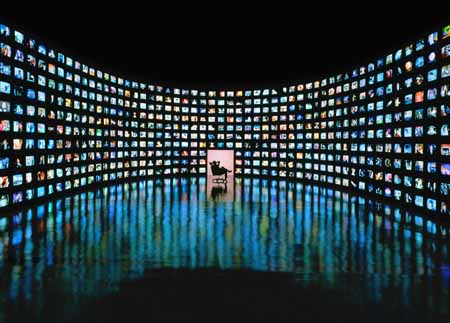
First Screen = Film
Second Screen = Television
Third Screen = Internet
Why do people talk to their television sets? Have television and real life become hopelessly intertwined? And scarier, have television sets literally become our friends? I recently spoke with Jonah Lehrer, author of Proust Was A Neuroscientist, about these and other questions.
T.T.: Do you think Proust would have watched television?
Lehrer: My sense is that he would have. He used to listen to live opera over the phone. In his essays, he comes back again and again to the way you are lost when you read, disappear into the medium. Books and television are both complex acts of disappearing.
T.T.: What actually happens in the brain when we read a book or watch television?
Lehrer: Television requires that we think a lot and invent worlds and keep track of characters, but when we watch The Sopranos, we're all watching the same Sopranos. I think the most complete act of imagination is still reading words on a page. The brain provides an incredible feat of cognition when we read. It transforms symbols on a page into a movie we create in our head. It reads a sentence. 'Jack was smiling.' The abstract communication is translated, and our mirror neurons light up as if we were smiling, too, a hot new brain circuit. The mirror neurons are involved in how we understand how someone else is feeling. In science, we call this dual process. The frontal cortex rationally takes in the information and farther back in the brain, the limbic system responds.
T.T.: Does someone real or imagined make us respond in the same way?
Lehrer: The brain is constantly confronted with ambiguous symbols. It does really well in making sense of those ambiguities. We may not see the same color red, but we pretend that it's all the same red. The visual cortex particularly excels at this. For example, we each have a blind spot in the middle of our visual field, but the brain seamlessly fills it in. Confronted with holes, we automatically make sense of it anyway.
T.T.: You've written about how, observing just a few brush strokes in a painting by Cezanne, the viewer will fill in the scene.
Lehrer: Yes. And similarly, if you show people a computer screen with just a few pixels and lines on it, representing a face, people will hypothesize that it's a face. As for television, its very nature is so cinematic that I think it is captivating to memory and naturally confuses us. Photographs can do this, too. I know that many of my memories are actually based on looking at family photographs.
T.T.: But you don't talk to those pictures.
Lehrer: When our computers crash we yell at them because we invest them with the qualities of something that has agency or intention -- something that is alive. The brain didn't evolve in a state including television. When the brain evolved, all animated creatures were living things, not electronic.
T.T.: So how do we relate to electronic communication?
Lehrer: Television has many human characteristics. It seems to be a little moody. It throws out different emotions. And the brain is slightly tricked by things that don't have agency and are not really alive. So you could construct a hypothesis that we talk to our television set not because we are lonely, but because our brain thinks it's "one of us."
This interview originally appeared as "The Thirteenth: Television and Loneliness" on www.thirteen.org